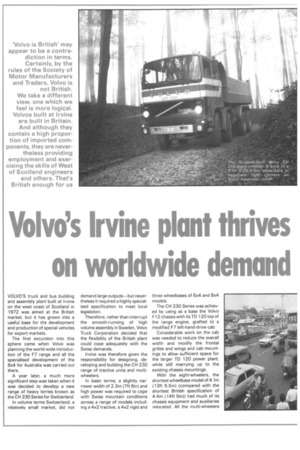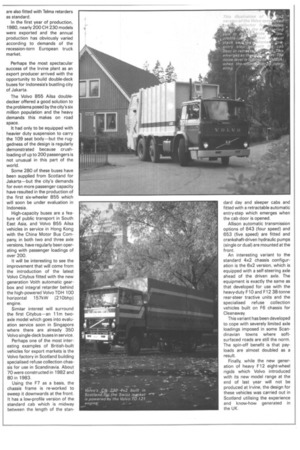on worldwide demand
Page 50

Page 52

If you've noticed an error in this article please click here to report it so we can fix it.
VOLVO'S truck and bus building and assembly plant built at Irvine on the west coast of Scotland in 1972 was aimed at the British market, but it has grown into a useful base for the development and production of special vehicles for export markets.
The first excursion into this sphere came when Volvo was planning the world-wide introduction of the F7 range and all the specialised development of the 8x4 for Australia was carried out there.
A year later, a much more significant step was taken when it was decided to develop a new range of heavy lorries known as the CH 230 Series for Switzerland.
In volume terms Switzerland, a relatively small market, did not demand large outputs—but nevertheless it required a highly specialised specification to meet local legislation.
Therefore, rather than interrupt the smooth-running of high volume assembly in Sweden, Volvo Truck Corporation decided that the flexibility of the British plant could cope adequately with the Swiss demands.
Irvine was therefore given the responsibility for designing, developing and building the CH 230 range of tractive units and multiwheelers.
In basic terms, a slightly narrower width of 2.3m {7ft 6in) and high power was required to cope with Swiss mountain conditions across a range of models including a 4x2 tractive, a 4x2 rigid and three wheelbases of 6x4 and 8x4 models.
The CH 230 Series was achieved by using as a base the Volvo F 12 chassis with its TD 120 top of the range engine, grafted to a modified 17 left-hand-drive cab.
Considerable work on the cab was needed to reduce the overall width and modify the frontal grilles and wings and cab mountings to allow sufficient space for the larger TD 120 power plant, white still marrying up to the existing chassis mountings.
With the eight-wheelers, the shortest wheelbase model of 4.1m (13ft 5.5in} (compared with the shortest British specification of 4.4m (14ft 5in)) had much of its chassis equipment and auxiliaries relocated. All the multi-wheelers are also fitted with Telma retarders as standard.
In the first year of production, 1980, nearly 200 CH 230 models were exported and the annual production has obviously varied according to demands of the recession-torn European truck market.
Perhaps the most spectacular success of the Irvine plant as an export producer arrived with the opportunity to build double-deck buses for Indonesia's bustling city of Jakarta.
The Volvo B55 Ailsa doubledecker offered a good solution to the problems posed by the city's six million population and the heavy demands this makes on road space.
It had only to be equipped with heavier duty suspension to carry the 109 seat body—but the ruggedness of the design is regularly demonstrated because crushloading of up to 200 passengers is not unusual in this part of the world.
Some 280 of these buses have been supplied from Scotland for Jakarta—but the city's demands for even more passenger capacity have resulted in the production of the first six-wheeler B55 which will soon be under evaluation in Indonesia.
High-capacity buses are a feature of public transport in South East Asia, and Volvo B55 AiIse vehicles in service in Hong Kong with the China Motor Bus Company, in both two and three axle versions, have regularly been operating with passenger loadings of over 200.
It will be interesting to see the improvement that will come from the introduction of the latest Volvo Citybus fitted with the new generation Voith automatic gearbox and integral retarder behind the high-powered Volvo TDH 100 horizontal 157kW (210bhp) engine.
Similar interest will surround the first Citybus—an 11m twoaxle model which goes into evaluation service soon in Singapore where there are already 350 Volvo single-deck buses in service.
Perhaps one of the most interesting examples of British-built vehicles for export markets is the Volvo factory in Scotland building specialised refuse collection chassis for use in Scandinavia. About 70 were constructed in 1982 and 80 in 1983.
Using the F7 as a basis, the chassis frame is re-worked to sweep it downwards at the front. It has a low-profile version of the standard cab which is midway between the length of the stan
dard day and sleeper cabs and fitted with a retractable automatic entry-step which emerges when the cab door is opened.
Allison automatic transmission options of 643 (four speed) and 653 (five speed) are fitted and crankshaft-driven hydraulic pumps (single or dual) are mounted at the front.
An interesting variant to the standard 4x2 chassis configuration is the 6x2 version, which is equipped with a self-steering axle ahead of the driven axle. The equipment is exactly the same as that developed for use with the heavy-duty F10 and F12 38-tonne rear-steer tractive units and the specialised refuse collection vehicles built on F6 chassis for Cleanaway.
This variant has been developed to cope with severely limited axle loadings imposed in some Scandinavian towns where softsurfaced roads are still the norm. The spin-off benefit is that payloads are almost doubled as a result.
Finally, while the new generation of heavy F12 eight-wheel rigids which Volvo introduced with its new model range at the end of last year will not be produced at Irvine, the design for these vehicles was carried out in Scotland utilising the experience and know-how generated in the UK.












































































































